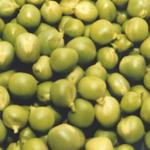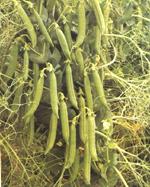| Fruits |
Vegetables
|
Pea, Pisum sativum / Leguminosae (Fabaceae)
|
Note: Composition for 100 g. of fresh product Values in ( min. - max. ) format. | |
| Energy: 75.00-83.00 kcal Fats: 0.48-1.50 g Fibres: 4.25-4.70 g Fat Acids Saturated: 0.30-0.30 gMonounsat.: 0.20-0.20 g Polyunsat.: 0.70-0.70 g Minerals Calcium: 21.00-36.00 mgZinc: 0.420-1.100 mg Chlorine: 39.00-40.00 mg Phosporus: 70.00-130.00 mg Iron: 1.20-2.80 mg Magnesium: 21.00-34.00 mg Manganese: 0.241-0.660 mg Potasium: 304.00-357.00 mg Selenium: 0.885-1.00 µg Sodium: 1.00-11.00 mg Iodine: 2.00-4.20 µg | Proteins: 6.40-6.90 kcal Carbohidrates: 10.80-12.30 g Liposoluble Vitamins A Retinol: 0.00-72.05 µgA Carotenoids: 29.00-440.63 µg E or Tocoferol: 0.21-2.04 mg K or Filoquinone: 33.40-33.40 µg Liposoluble Vitamins B1 or Thiamine: 0.287-0.740 mgB2 or Riboflavine: 0.020-0.160 mg B3 or Niacine: 1.10-2.50 mg B5 or Pantothenic Acid: 0.150-0.720 mg B6 or Piridoxine: 0.120-0.160 mg B9 or Folic Acid: 20.00-25.00 mg C or Ascorbic Acid: 20.00-25.00 mg |
|
Note: Composition for 100 g. of fresh product Values in ( min. - max. ) format. | |
| Energy: 70.10-79.00 kcal Fats: 0.50-1.60 g Fibres: 4.50-4.50 g Fat Acids Saturated: 0.30-0.30 gMonounsat.: 0.20-0.20 g Polyunsat.: 0.70-0.70 g Minerals Calcium: 19.00-22.00 mgZinc: 1.00-1.00 mg Chlorine: 8.00-8.00 mg Phosporus: 91.00-130.00 mg Iron: 1.30-1.50 mg Magnesium: 29.00-29.00 mg Manganese: 0.40-0.40 mg Potasium: 213.00-230.00 mg Selenium: 1.00-1.00 µg Sodium: 2.00-2.00 mg Iodine: 2.00-2.00 µg | Proteins: 5.60-6.70 kcal Carbohidrates: 10.00-10.80 g Liposoluble Vitamins A Retinol: 0.00-0.00 µgA Carotenoids: 350.00-350.00 µg E or Tocoferol: 0.21-0.21 mg K or Filoquinone: 23.00-23.00 µg Liposoluble Vitamins B1 or Thiamine: 0.23-0.70 mgB2 or Riboflavine: 0.030-0.160 mg B3 or Niacine: 1.80-1.80 mg B5 or Pantothenic Acid: 0.15-0.15 mg B6 or Piridoxine: 0.090-0.090 mg B9 or Folic Acid: 16.00-17.00 mg C or Ascorbic Acid: 16.00-17.00 mg |

It is one of the oldest edible plants and probably one of the first cultivated. It is a pod of green colour (pale or dark, according to the variety), more or less compressed, in many cases cylindrical and tapered to the ends. The pods are usually 8 to 10 cm long, even and bright. They contain an undetermined number of seeds (7-9) that are the edible fruits; the grains are tender if they are harvested before they reach maturity, with a sweet taste when they are consumed raw.
Nutrition and eating
Fresh peas are a type of green vegetable with a great nutritious and energetic supply. They are considered to be highly tonic, since they are rich in proteins, carbohydrates and minerals. Moreover, they have a low content of lipids and do not contain cholesterol.
The fruit
 The pea, Pisum sativum, is a herbaceous plant belonging to the family of leguminous plants. The seeds are usually eaten green, dry, in preserve or frozen. The pod of some species is consumed along with the seeds, like French beans.
The pea, Pisum sativum, is a herbaceous plant belonging to the family of leguminous plants. The seeds are usually eaten green, dry, in preserve or frozen. The pod of some species is consumed along with the seeds, like French beans. Peas represent an important source of proteins, with an average biological value. The dry seeds are hypercaloric and rich in iron.
It is one of the oldest edible plants and probably one of the first cultivated. It is a pod of green colour (pale or dark, according to the variety), more or less compressed, in many cases cylindrical and tapered to the ends. The pods are usually 8 to 10 cm long, even and bright. They contain an undetermined number of seeds (7-9) that are the edible fruits; the grains are tender if they are harvested before they reach maturity, with a sweet taste when they are consumed raw.
Peas are used in multiple stews or raw in salads, sautéed with ham, fried, or as a tasty garnish for meat, fish or game.
Many processing industries have been established near the production areas. Peas are ideal for canning and freezing, since they keep their organoleptic properties.
The peas are green seeds, therefore they are unripe seeds and they have a high nutritious value. Their consumption is very important for the organism. They contain 7% of protein and 12% of carbohydrate, their caloric value is 80 calories for each 100 grams of fruit. The pea is a highly powerful food; it has a low vitamin content.
Trade in fresh is in decline, perhaps because we have to pod the fruits. In spite of it, the consumption of this fruit is increasing, as well as the production, being the industry the main client for farmers.
The plant

Peas (Pisum sativum) are the fruits of an annual herbaceous plant belonging to the family of leguminous. This plant is chiefly cultivated for its seeds, consumed in fresh state, when they are sweet and tender. Only the fresh vegetable of some varieties is consumed.
The plant has a hypogeous germination with a slightly developed root system altogether, although the tap root may be quite deep. Angular stems of variable section and habit. There are three varietal groups of peas: dwarf varieties, whose stem are between 35 and 60 cm long; semidwarf varieties, whose stems measure between 60 and 70 cm; and creeping varieties, with stems measuring between 100 and 180 cm. It is necessary to highlight that there are slight differences in the classification of varieties.
Their leaves have between 2 and 8 folioles, of a glaucus-green colour, sometimes mottled, ending in a simple tendril and two large stipules on the base.
Isolated flowers or in groups of three or four, autogamous fertilization; the corolla is usually of a whitish colour in the varieties that are cultivated for their seeds and purple in the case of edible-poddedpeas. The flowers may appear in different nodes of the stem, depending on the variety.
The fruit is a vegetable or pod, of variable shape and size and globulose or cubical, even or wrinkled seeds, each pod containing from 4 to 12 seeds.
The weight of 1,000 seeds is around 200 g and its germination capacity is approximately of three years.
The plant has a hypogeous germination with a slightly developed root system altogether, although the tap root may be quite deep. Angular stems of variable section and habit. There are three varietal groups of peas: dwarf varieties, whose stem are between 35 and 60 cm long; semidwarf varieties, whose stems measure between 60 and 70 cm; and creeping varieties, with stems measuring between 100 and 180 cm. It is necessary to highlight that there are slight differences in the classification of varieties.
Their leaves have between 2 and 8 folioles, of a glaucus-green colour, sometimes mottled, ending in a simple tendril and two large stipules on the base.
Isolated flowers or in groups of three or four, autogamous fertilization; the corolla is usually of a whitish colour in the varieties that are cultivated for their seeds and purple in the case of edible-poddedpeas. The flowers may appear in different nodes of the stem, depending on the variety.
The fruit is a vegetable or pod, of variable shape and size and globulose or cubical, even or wrinkled seeds, each pod containing from 4 to 12 seeds.
The weight of 1,000 seeds is around 200 g and its germination capacity is approximately of three years.
| Interempresas Media, S.L. / 2025 | [ Legal notice | Política de Protección de Datos | Política de cookies | Publicidad] |
